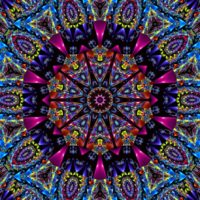 “There was also no longer any sense of my moving along a timeline. Time was no longer a path with the past behind me and the future before me, as we commonly conceive of it. Instead there was a sense of an eternally unfolding present moment. Rather than time being a journey along a linear path, change appeared to be mandala-like. It seemed to be like a flower seen from above, endlessly unfolding from within, or like a kaleidoscope’s image forever rearranging itself. It struck me as highly misleading to think in terms of there being a past behind us and a future ahead of us. Instead there was only this one present moment, eternally unfolding according to its nature. I found myself in an eternal, timeless present.”
“There was also no longer any sense of my moving along a timeline. Time was no longer a path with the past behind me and the future before me, as we commonly conceive of it. Instead there was a sense of an eternally unfolding present moment. Rather than time being a journey along a linear path, change appeared to be mandala-like. It seemed to be like a flower seen from above, endlessly unfolding from within, or like a kaleidoscope’s image forever rearranging itself. It struck me as highly misleading to think in terms of there being a past behind us and a future ahead of us. Instead there was only this one present moment, eternally unfolding according to its nature. I found myself in an eternal, timeless present.”
The passage above is from Living As A River. I have a little trouble with the flower image but really like the kaleidoscope analogy. I even bought a small one and enjoy watching the tiny pieces of glass rearranging themselves. How many different patterns are possible, I wondered. I thought it would be a matter of permutations and combinations but couldn’t find a formula. I did find this from the Encyclopaedia Britannica:
“The kaleidoscope was invented by Sir David Brewster about 1816 and patented in 1817. Sold usually as a toy, the kaleidoscope also has value for the pattern designer. […] The number of combinations and patterns is effectively without limit.
That surprises me a little. If there are x pieces of glass, it would seem there would be a finite number of combinations. But for the purposes of the analogy, “without limit” works just fine. But another question occurs to me: Is there a way to compute the probability the exact same pattern will repeat? But I’ve drifted pretty far from the “present moment.”
The image of our lives as a road stretching from birth to death, always in one direction, is pretty grooved into my psyche. But I like the kaleidoscope better. All the tiny, colored pieces of my existence, rearranging themselves, moment to moment, never the exact same pattern twice. Yes. That’s a more interesting way to imagine time.
